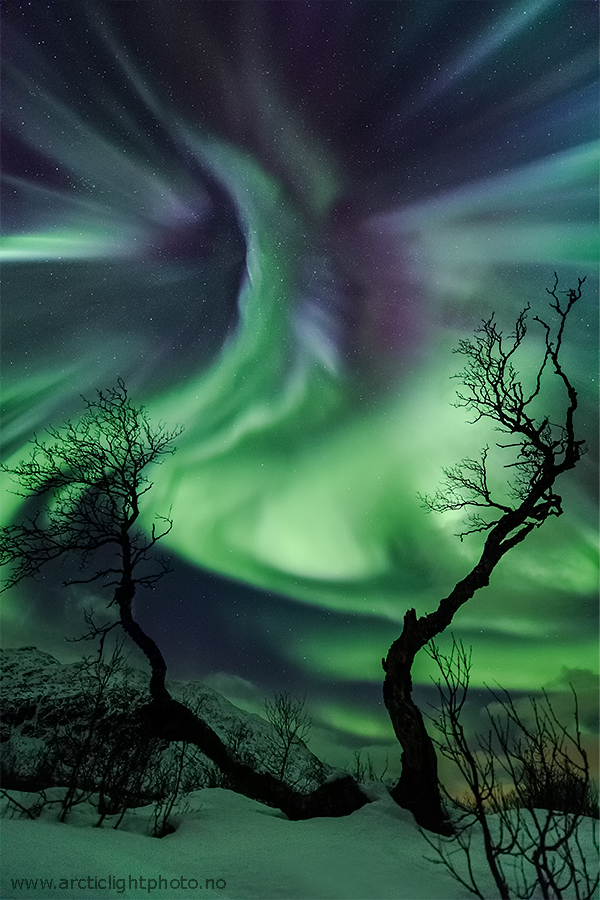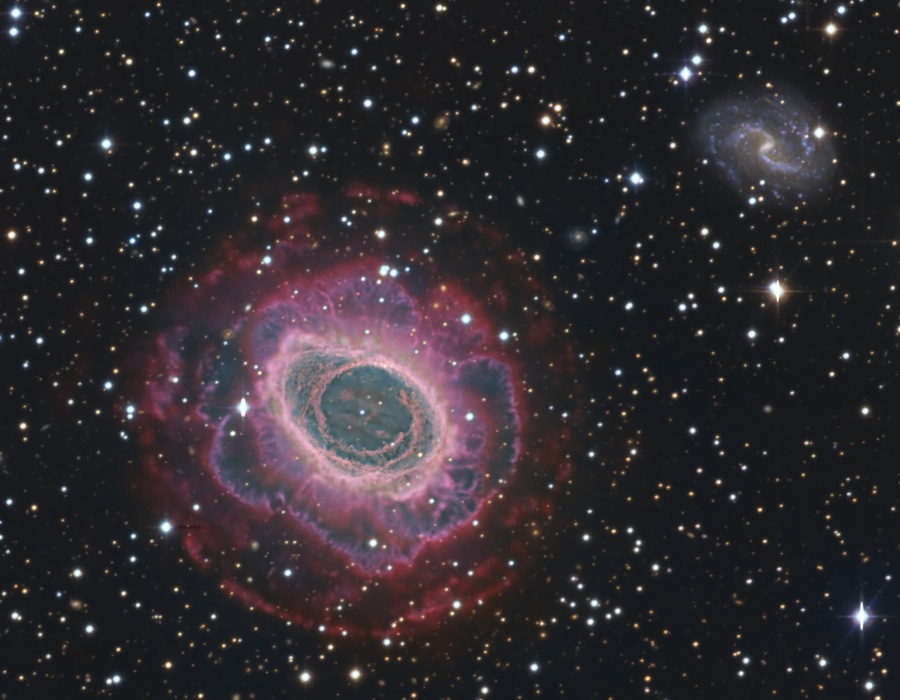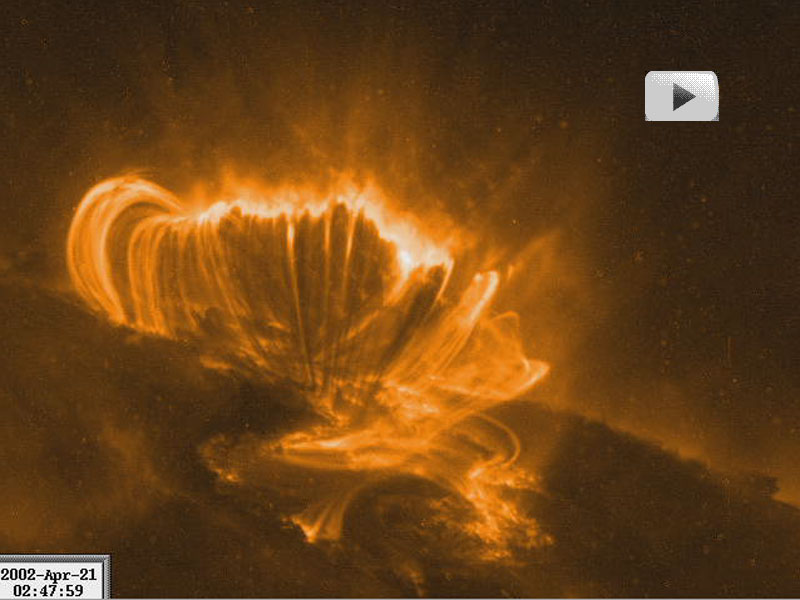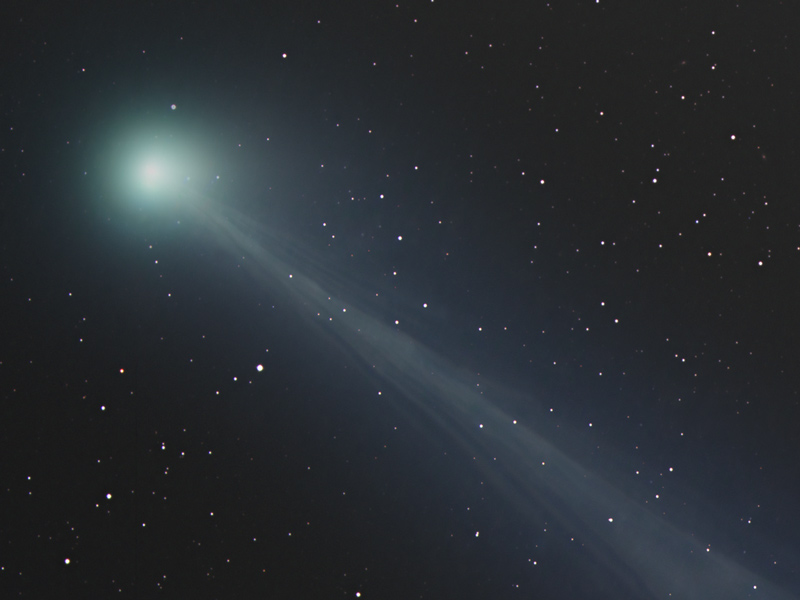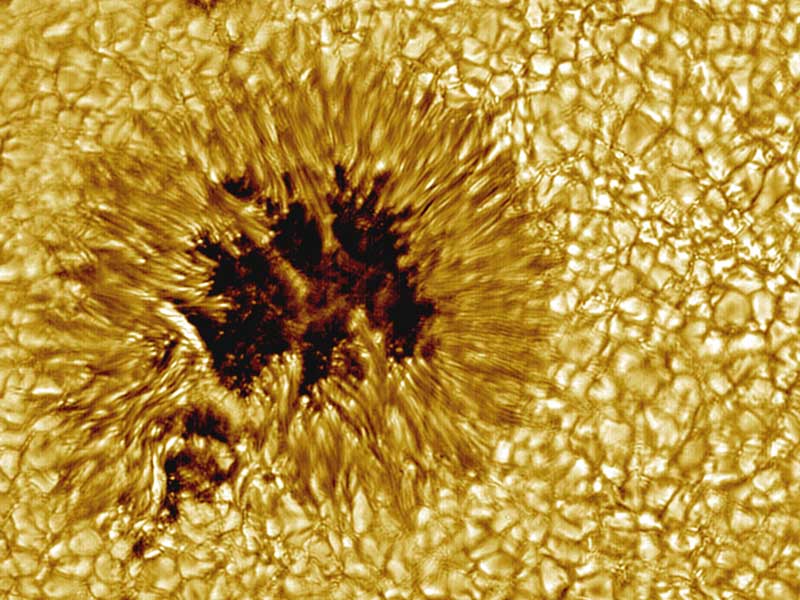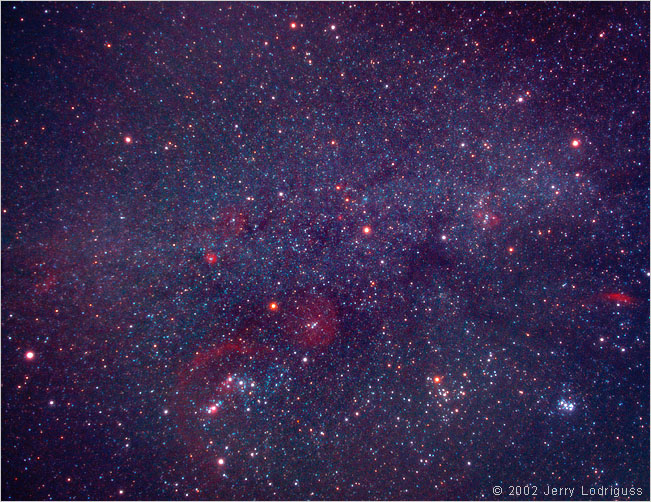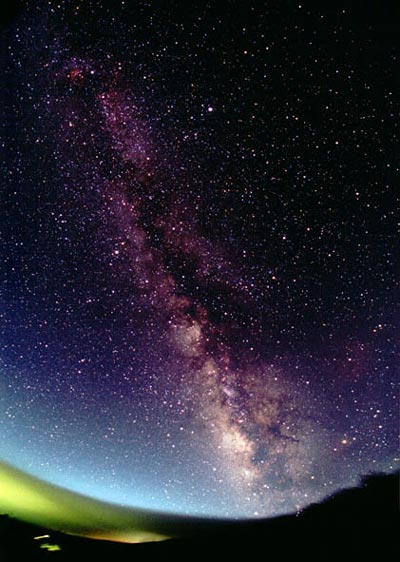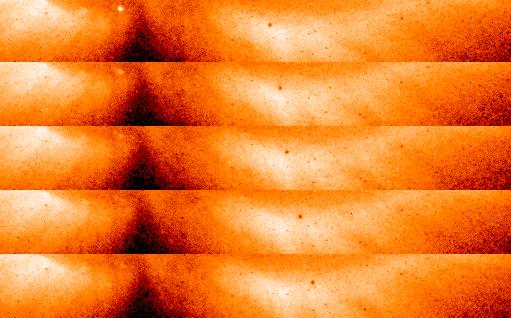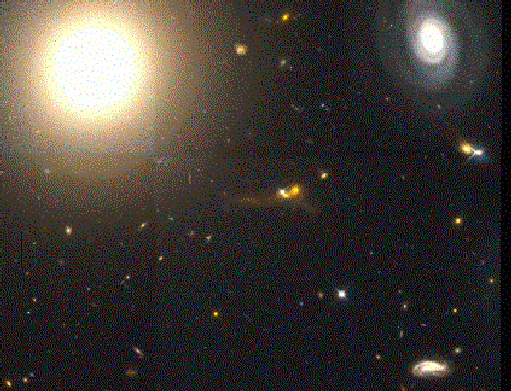| << Previous | Index | Next >> |
2014 This colorful skyscape features the dusty Sharpless catalog emission region Sh2-155, the Cave Nebula. In the composite image, data taken through narrowband filters tracks the glow of ionized sulfur, hydrogen, and oxygen atoms in red, green, and blue hues. About 2,400 light-years away, the scene lies along the plane of our Milky Way Galaxy toward the royal northern constellation of Cepheus. Astronomical explorations of the region reveal that it has formed at the boundary of the massive Cepheus B molecular cloud and the hot, young stars of the Cepheus OB 3 association. The bright rim of ionized interstellar gas is energized by radiation from the hot stars, dominated by the bright star just above picture center. Radiation driven ionization fronts are likely triggering collapsing cores and new star formation within. Appropriately sized for a stellar nursery, the cosmic cave is over 10 light-years across.
2013 It was Halloween and the sky looked like a creature. Exactly which creature, the astrophotographer was unsure (but possibly you can suggest one). Exactly what caused the eerie apparition was sure: one of the best auroral displays in recent memory. This spectacular aurora had an unusually high degree of detail. Pictured above, the vivid green and purple auroral colors are caused by high atmospheric oxygen and nitrogen reacting to a burst of incoming electrons. Birch trees in Tromsø, Norway formed an also eerie foreground. Many other photogenic auroras have been triggered by recent energetic flares on the Sun.
2012 Why is this moon shaped like a smooth egg? The robotic Cassini spacecraft completed the first flyby ever of Saturn's small moon Methone in May and discovered that the moon has no obvious craters. Craters, usually caused by impacts, have been seen on every moon, asteroid, and comet nucleus ever imaged in detail -- until now. Even the Earth and Titan have craters. The smoothness and egg-like shape of the 3-kilometer diameter moon might be caused by Methone's surface being able to shift -- something that might occur were the moon coated by a deep pile of sub-visual rubble. If so, the most similar objects in our Solar System would include Saturn's moons Telesto, Pandora, Calypso, as well as asteroid Itokawa, all of which show sections that are unusually smooth. Methone is not entirely featureless, though, as some surface sections appears darker than others. Although flybys of Methone are difficult, interest in the nature and history of this unusual moon is sure to continue.
2011
Click to play embedded YouTube video.
Image Credit & Copyright: Bruno Sánchez-Andrade Nuño et al. (IAG & MPS, NRL)
2010 Like an illustration in a galactic Just So Story, the Elephant's Trunk Nebula winds through the emission nebula and young star cluster complex IC 1396, in the high and far off constellation of Cepheus. Of course, the cosmic elephant's trunk is over 20 light-years long. This composite was recorded through narrow band filters that transmit the light from ionized hydrogen, sulfur, and oxygen atoms in the region. The resulting image highlights the bright swept-back ridges that outline pockets of cool interstellar dust and gas. Such embedded, dark, tendril-shaped clouds contain the raw material for star formation and hide protostars within the obscuring cosmic dust. Nearly 3,000 light-years distant, the relatively faint IC 1396 complex covers a large region on the sky, spanning over 5 degrees. This dramatic close-up covers a 2 degree wide field, about the size of 4 Full Moons.
2009
2008 This dramatic image of Jupiter is touted as the sharpest picture of the entire gas giant ever taken from the ground. The picture was made using a prototype instrument known as MAD (Multi-conjugate Adaptive optics Demonstrator) mounted on one of the European Southern Observatory's 8-meter diameter Very Large Telescope units in Chile. Working at infrared wavelengths the MAD instrument removes atmospheric blurring, the bane of earthbound telescopes, by using multiple guide stars and deformable mirrors to sense and correct for the distortions produced by turbulence in Earth's atmosphere. Hydrogen and methane deep in Jupiter's own thick atmosphere absorb light at infrared wavelengths. So, this sharper view shows the infrared sunlight reflected from the giant planet's high level haze prominent in the equatorial regions and near the poles. It reveals features as small as 300 kilometers across. The promising technique can also be applied to imaging other extended objects like star clusters and nebulae.
2007 Why does the Sun flare? Unpredictably, our Sun unleashes tremendous flares expelling hot gas into the Solar System that can affect satellites, astronauts, and power grids on Earth. This close up of an active region on the Sun that produced a powerful X-class flare was captured by the orbiting TRACE satellite. Clicking on the image should bring up a movie that shows the evolution of Active Region 9906 over about four hours. The glowing gas flowing around the relatively stable magnetic field loops above the Sun's photosphere has a temperature of over ten million degrees Celsius. These flows occurred after violently unstable magnetic reconnection events above the Sun produced the flare. Many things about solar active regions are not well understood including the presence of dark regions that appear to move inward during the movie.
2006 What causes the structure in Comet SWAN's tail? Comet SWAN, which unexpectedly flared up to naked-eye brightness last week, has been showing detail in its ion tail that might be described as ghostly. The ion tail is made of ionized gas, energized by ultraviolet light from the Sun and pushed outward by the solar wind. The solar wind itself is quite structured and sculpted by the Sun's complex and ever changing magnetic field. Following the wind, structure in Comet SWAN's tail can be seen to move outward from the Sun even alter its wavy appearance over time. The blue color of the ion tail is dominated by recombining carbon monoxide atoms. The color of the coma surrounding the head of the comet is tinged green by slight amounts of the molecule cyanogen. The above image was taken last week from California, USA. This week may be the best remaining chance for northern hemisphere observers to see the fading interplanetary snowball. SWAN has now passed both the Earth and the Sun and will fade as it moves away from the Earth and heads out into the vast space between the stars.
2005 Why would a small part of the Sun appear slightly dark? Visible above is a close-up picture of a sunspot, a depression on the Sun's face that is slightly cooler and less luminous than the rest of the Sun. The Sun's complex magnetic field creates this cool region by inhibiting hot material from entering the spot. Sunspots can be larger than the Earth and typically last for only a few days. This high-resolution picture also shows clearly that the Sun's face is a bubbling sea of separate cells of hot gas. These cells are known as granules. A solar granule is about 1000 kilometers across and lasts about 10 minutes. After that, many granules end up exploding.
2004 Using the orbiting Chandra X-ray Observatory, astronomers have taken this long look at the core of our Milky Way galaxy, some 26,000 light-years away. The spectacular false-color view spans about 130 light-years. It reveals an energetic region rich in x-ray sources and high-lighted by the central source, Sagittarius A*, known to be a supermassive black hole with 3 million times the mass of the Sun. Given its tremendous mass, Sagittarius A* is amazingly faint in x-rays in comparison to central black holes observed in distant galaxies, even during its frequent x-ray flares. This suggests that this supermassive black hole has been starved by a lack of infalling material. In fact, the sharp Chandra image shows clouds of multi-million degree gas dozens of light-years across flanking (upper right and lower left) the central region -- evidence that violent events have cleared much material from the vicinity of the black hole.
2003 Almost out of view from our fair planet, rotating around the Sun's western edge, giant sunspot region AR 10486 lashed out with another intense solar flare followed by a large coronal mass ejection (CME) on Tuesday, November 4th at about 1950 Universal Time. The flare itself is seen here at the lower right in an extreme ultraviolet image from the sun-staring SOHO spacecraft's EIT camera. Saturating the EIT camera pixels and detectors on other satellites, this giant X-class flare was among the most powerful ever recorded since the 1970s, the third such historic blast from AR 10486 within the last two weeks. While energetic particle radiation from the flare did cause substantial radio interference, the associated CME is not expected to trigger extremely widespread aurorae as it glances off the magnetosphere, unlike the direct hits from last week's CMEs. Say farewell to the mighty AR 10486, for now. For the next two weeks, the sunspot region will be on the Sun's far side.
2002 Some of the brightest stars form a large and easily found pattern in the winter sky of Earth's northern hemisphere. Dubbed the Winter Hexagon, the stars involved can usually be identified even in the bright night skies of a big city. The six stars that compose the Winter Hexagon are Aldebaren, Capella, Castor, Procyon, Rigel, and Sirius. Rolling your cursor over the above image will identify them. The Winter Hexagon asterism engulfs several constellations including Orion and Canis Major.
2001 What's happening at the center of spiral galaxy M83? Just about everything, from the looks of it. M83, visible in the inset image on the upper left, is one of the closest spiral galaxies to our own Milky Way Galaxy and from a distance of 15 million light-years, appears to be relatively normal. Zooming in on M83's nucleus with the latest telescopes, however, shows the center to be an energetic and busy place. Visible in the above image from the Hubble Space Telescope are bright, newly formed stars and giant lanes of dark dust. An image with similar perspective from the Chandra X-ray Observatory shows the region is also rich in very hot gas and small bright sources. Observations with the large ground-based VLT telescopes show the very center likely has two separate nuclei.
2000 If sometimes it appears that the entire Milky Way Galaxy is raining down on your head, do not despair. It happens twice a day. As the Sun rises in the East, wonders of the night sky become less bright than the sunlight scattered by our own Earth's atmosphere, and so fade from view. They will only rotate back into view when the Earth again eclipses our bright Sun at dusk. This battle between heaven and Earth was captured dramatically above during the last few minutes of daylight on 1999 August 10 in Koumi, Japan. Dark dust, millions of stars, and bright glowing red gas highlight the plane of our Milky Way Galaxy, which lies on average thousands of light years behind Earth's yellow and green reflecting clouds.
1999 This sequence of false color X-ray images captures a rare event - the passage or transit of planet Mercury in front of the Sun. Mercury's small disk is silhouetted against the bright background of X-rays from the hot Solar Corona. It appears just to the right of center in the top frame and moves farther right as the sequence progresses toward the bottom. The dark notch is a coronal hole near the Solar South Pole, while a flaring coronal bright point can be seen to the left of the notch in the top frames. The frames were recorded on November 6, 1993 by the Soft X-ray Telescope on board the orbiting Yohkoh satellite. Transits of Mercury (and Venus) were historically used to discover the geometry of the solar system and to map planet Earth itself. The next transit of Mercury will occur on November 15.
1998 Cruising past the moons of reigning gas giant Jupiter, Voyager and Galileo have returned tantalizing evidence for a liquid water ocean beneath the surface of Europa. Now researchers are reporting telltale indications that the battered Jovian moon Callisto may also harbor a subsurface ocean. This cutaway view of Callisto shows a whitish 200 kilometer thick band of ice just beneath the moon's surface. The hypothetical ocean - indicated by the underlying light blue stripe - is potentially a salty layer of liquid water up to 10 kilometers thick, while the rest of the interior is seen as a jumble of rock and ice. Why a salty subsurface ocean? Magnetic measurements made during Galileo flybys so far indicate Callisto's magnetic field is variable, analogous to results during Europa passes, and a plausible explanation is that Callisto too has a subsurface liquid layer. If the liquid were salt water it could easily carry electrical currents and produce the changing magnetic field.
1997 The Sun has a magnetic carpet. Its visible surface appears to be carpeted with tens of thousands of magnetic north and south poles joined by looping field lines which extend outward into the Solar Corona. Recently, researchers have revealed maps of large numbers of these small magnetic concentrations produced using data and images from the space-based SOHO observatory. The above computer generated sunscape highlights these effects, with white and black field lines drawn in joining regions of strong magnetism. A close-up of the Solar surface is illustrated in the inset. These small magnetic regions emerge, fragment, drift, and disappear over periods of only 40 hours or so. Their origin is mystifying and their dynamic behavior is difficult to reconcile with present theories of rotationally driven large-scale Solar Magnetism. Is some unknown process at work? Possibly, but the source of this mystery may well be the solution to another -- the long standing mystery of why the outer Solar Corona is over 100 times hotter than the sun's visible surface! The SOHO data reveal that energy released as these loops break apart and interact seems to be heating the coronal plasma.
1996 Elliptical galaxies are unlike spiral galaxies and hence unlike our own Milky Way Galaxy. The giant elliptical galaxy named NGC 4881 on the upper left lies at the edge of the giant Coma Cluster of Galaxies. Elliptical galaxies are ellipsoidal in shape, contain no spiral arms, contain little interstellar gas or dust, and are found mostly in rich clusters of galaxies. Elliptical galaxies appear typically yellow-red, as opposed to spirals which have spiral arms that appear quite blue. Much speculation continues on how each type of galaxy can form, on whether ellipticals can evolve from colliding spirals, or spirals can be created from colliding ellipticals, or both. Besides the spiral galaxy on the right, all other images in this picture are of galaxies that lie well behind the Coma Cluster.
1995 How do stars form? This stunning picture taken recently by the Hubble Space Telescope gives us a first hand glimpse. Here evaporating gaseous globules (EGGs) are captured emerging from pillars of molecular hydrogen and dust in the Eagle Nebula (M16). These pillars, dubbed "elephant trunks," are light years in length and are so dense that interior gas gravitationally contracts to form stars. At each pillars' end, the intense radiation of bright young stars causes low density gas to boil away, leaving stellar nurseries of dense EGGs exposed.
| << Previous | Index | Next >> |

